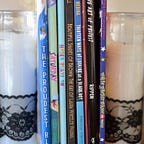Ninth Ward, Voudou, & the connection between art & spirituality.
I quite enjoyed reading Ninth Ward, by Jewell Parker Rhodes. What I loved were the elements of voudou, spirituality, ghosts and engagement with other realms. I loved the descriptions of sensory awareness of a spirit, the glimpse at Mama Ya-Ya’s altar, the conversations with ghosts, the sensing of the weather to come. I have always been captivated by these kinds of practices.
I grew up in a home without religion, and with a mother who absolutely carries some witchy, energy moving vibes, but kept these largely from us when we were young. Or at least, it was unspoken. Which is to say, I wasn’t indoctrinated in anything, and had no ritual, no ceremony. I desperately yearned for these things. I wanted beliefs to be spoken. I wanted an initiation.
When I read books like this, I am reminded of that young desire I had to borrow other people’s practices, beliefs, traditions. I wanted to have what they had. Which is innocent enough, but there are some things-cultural inheritances-that cannot just be had by anyone who wants them. I do think one can appreciate without appropriating though. And can then gather that inspiration to make our own rituals and belief system.
This book doesn’t make it specific, but given that this takes place in New Orleans, the home of voudou, and the once residence of the voudou queen, herbalist, and midwife, Marie Leveau, it is impossible for me not to assume some influence of this religion/belief system in this book. I see traces of voudou in Mama Ya-Ya and Lanesha’s sight and sensing of other worlds and spirits. And given voudou’s rich history of Roman Catholicism mixing up with all sorts of religions and beliefs brought over with the enslaved people from many parts of Africa, voudou is one such practice that cannot exactly be had by anyone who wants it, steeped as it is in the traditions and histories of enslaved and formerly enslaved people.
There is a yumminess of ritual, magic, intuition that is present in this book, alongside all of the difficulties Lanesha faces, and the tragedy of what happened to the Ninth Ward in New Orleans. This book beautifully wove two story lines-that of the very real and present dangers Katrina brought to this part of the world, and the calming, empowering presence of ghosts Lanesha was able to learn from and lean on.
Throughout my whole childhood I had a longing for this kind of sacredness. I wanted the empowering presence of some god, some belief, some entity beyond this plane. I wanted this magic and ritual that I read in books just like this one into until, when I discovered it could be found in art. In art, ceremony, and a sense of the sacred, become available for everyone. Art, and all of its ritual, context, history, magic, realm-opening abilities, belongs to anyone who practices the making, or appreciation, of it, for anyone who decides it is a temple to bend toward.
Art is a spiritual practice for me. It has given me a lens to approach the world, to view my circumstances through, to understand my reactions and responses. Centering art, being devoted to it in nearly every aspect of life has given me access to thoughts, emotions, revelations and intuitions beyond what I previously knew. We can see in this book how a belief system, how a different epistemology, can really influence and shape the way one views her world and circumstances. The calm knowing that Lanesha found when Mama Ya-Ya died is one such example of this. In that moment, she saw the intricacies of life, the complexity, the resilience of spirit, the ability to access knowledge and intuition beyond what this plane of reality allows or accepts.
Art, too, is a portal to other ways of knowing about this world. It is an avenue to explore curiosities, impulses, intuitions, magic, ritual, sacredness.
Museums as church. Art as devotion. Artists as leaders.
Art appreciation can be a form of reverence, can be made into an offering. Can be healing.
Originally published at https://goodtroubleforkids.substack.com.
